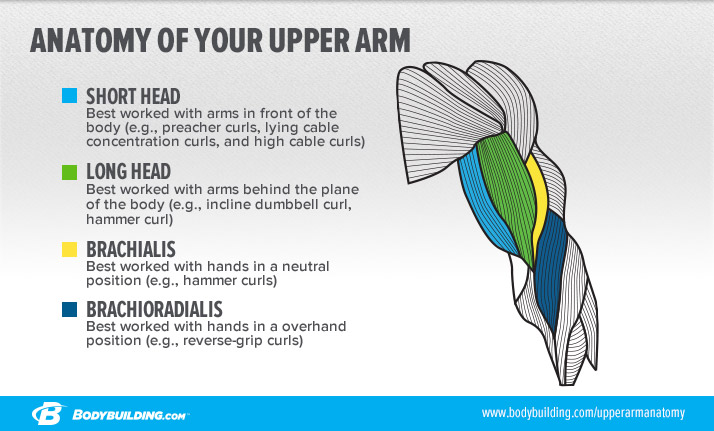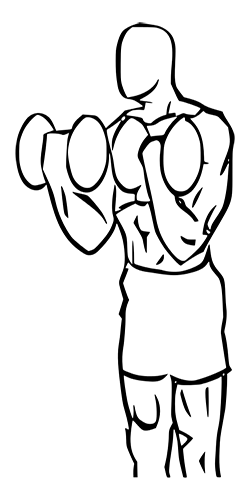One of a lot of people’s goal is to get bigger arms. That’s why you will see every beginner going to the dumbbells and starting to rep out on some curls. Even though there are more ways, you want to know what the best way to get bigger arms is. The size of the arm is mainly given by the triceps, but let’s talk biceps for a second.
Since everybody wants to get the best out of their workout, questions such as hammer curls vs regular curls popped up.
So which one is better?
The answer is: it depends on your goals. For a more detailed answer I will get into just a bit of anatomy, aided by a picture to simplify everything.
The anatomy of the anterior compartment of the arm:

Source: www.bodybuilding.com
The region between the shoulder and the elbow is referred to as arm. Another name for that region is ‘brachium’, which is the Latin word for arm. The muscles in this region will have some version of that word.
The anterior compartment of the arm is composed of 3 muscles: the biceps, the brachialis and the coracobrachialis. In this article we will only discuss about the biceps and the brachialis.
The biceps brachii:
These are the muscles a lot of people want to build up, and the reason for which you are here. This muscle has 2 heads: the long head and the short head, hence the name ‘biceps’.
The long head of the biceps is the muscle located on the outside of the arm. It is responsible for the peak you get when contracting your biceps.
The short head is located on the inside of the arm. This muscle is responsible for the thickness of the biceps. If you don’t focus on developing the short head your arms will look normal-sized from the front, even if from the sides they would look huge.
- What exercises train which head?
You should not concentrate too much on working a certain head over the other, because this muscle group is relatively small and can be easily over trained. With that said, these are the exercises that focus more on one that the other:
1. The long head
• Incline dumbbell curls
• Hammer curls
2. The short head
• Preacher curls
• Lying cable concentration curls
• High cable concentration curls
You should also note that this muscle group works along with other groups, such as the back muscles. This means that it’s important to focus not only on isolation exercises, but multi-joint exercises as well, for the best results.
The brachialis:
This muscle sits underneath your biceps. The brachialis is visible to a small degree, on the side of your arm, but only when the elbow is flexed. If you are lean this muscle will be visible in between your biceps and triceps.
So how does it help with your gains?
You can increase the thickness of your arm, as well as push your biceps out, by increasing the size of this muscle.
Functions:
These muscles help with the flexion of the elbow and the supination of the forearm.
Note: When curling, people often call this movement flexing of the biceps. The muscle is actually contracting and you are actually flexing the elbow joint.
Regular curls vs hammer curls :
Now that the anatomy lesson is over we can finally get to business.
I know that you are here to develop some gains, but I strongly believe that knowing the stuff we have just talked about will help you tremendously in taking muscle-building decisions.
- Regular curls
This has to be one of the most well known exercises ever. Not only that, but I believe this is the first thing anyone has ever done with a dumbbell.
The regular curl, also known as bicep curl, mainly works the biceps brachii with minimum aid from other muscles. In fact, other muscles are involved so little that they won’t even be taken into consideration in this article.
- Form
Supination (for arms) is a rotation movement towards the outside, so the palm is facing up.
Start in a supinated position. Keep this position for the entirety of the range of motion, since that is how you target the biceps the most.
Keep your elbow right in front of your hips. Bring the dumbbell all the way up then back down for maximum biceps effort. Try to keep the elbow in front of your hips at all times because you will feel a lot more bicep activation when doing the eccentric movement (negative).
A common misconception is that if you go for the full range of motion you take tension out of the exercise. I don’t agree with this. Most muscle fiber is getting broken up during the eccentric movement (negative). If you go all the way up to your shoulder there is a longer ROM (range of motion) to control the weight on the way down. That means more fiber broken up.

- Hammer curls
As with the regular curls, in this variation you are still targeting the biceps, but it works to support other muscles do more of the work.
The hammer curl works the brachioradialis (which is one of the muscles of the forearm) and the brachialis, alongside with the biceps. It is true that the biceps is not engaged as much as it is in the regular curls. The brachialis if grown, though, will increase the bicep peak.
- Form
Start with the palms facing in. This position allows you to target the brachioradialis more since the muscle is the strongest in this position. Keep the elbow in one position (as with the regular curls), bring the dumbbell all the way up to the shoulder, then all the way down.
Control the weight down because that’s when you break most muscle.

1. Muscle engagement between the two
The regular curl engages mainly the biceps brachii with minimal assist of the brachialis and brachioradialis. Upper back muscles and forearm muscles contract to work as stabilizers, but they do not lengthen nor shorten.
The hammer curls work the biceps (less than the regular curl) but also emphasizes a lot on the brachioradialis – which is the muscle starting from the wrist all the way to your elbow – and the brachialis.
2. Advantages of the two variations
Given that the biceps curls (regular curls) are done in a supinated position, they target the muscle way better than the hammer curls. Not only that, but it’s harder to cheat reps of this exercise, due to the position of your forearms.
A huge advantage of the hammer curls variation is that, holding the dumbbell in a way that’s pointing up and down, there is no added stress on your wrists. With standard curls there is wrist engagement to support the lift, while there is no wrist engagement whatsoever in the hammer curls.
Which one should you choose?
Now that we have laid all this information for you, the question still remains: which of the two variations should you choose? Even though it may surprise you, the answer is: you should choose both of them.
You could do more of one variation than you do of the other, depending on your goals. If your sole purpose is to emphasize on the biceps, then your go-to exercise is the regular curl. If, on the other hand, your goal is to have overall good looking arms with no imbalances, then you should do more of the hammer curl variation.
Tips:
1. Less weight, more control
One of the best tips I can give you is to do them slowly. I know you’ve heard this a million times but trust me when I say that it’s the best thing you can do to maximize your results. I see way too many people making this mistake.
I know, you might get a good pump from swinging the weights around, but that’s because your whole upper body is working to swing the given weight. If you focus on proper form with less weight, though, it will make all the difference in the world.
If you have the habit of swinging just do the exercises while seated. This should prevent you from swinging. Sit on a bench or chair that supports your back. Keep a straight back, tighten up the core and move the arms up and down keeping them fixed in one position.
2. Mix variations up
Get rid of the ‘one vs another’ mentality and do all of the variations. They all focus on different muscles to some extent; they all have pros and cons. Don’t just train one exercise or the other. Mix them up, see how you feel. Experiment. That’s how you get to learn and get huge gains in the process.
Final thoughts:
After reading this you should have a general idea of how your arms work ‘behind the scenes’. You should also have a general idea of how the two variations discussed in this article work and which one to choose depending on your goals.
Remember to take into consideration the tips I’ve given you. If you do, not only that you will train better, but you will also understand why it’s not a matter of ‘regular curls vs hammer curls’, but a matter of when to train each of them.
Congratulations @amru82! You received a personal award!
You can view your badges on your Steem Board and compare to others on the Steem Ranking
Vote for @Steemitboard as a witness to get one more award and increased upvotes!
Downvoting a post can decrease pending rewards and make it less visible. Common reasons:
Submit